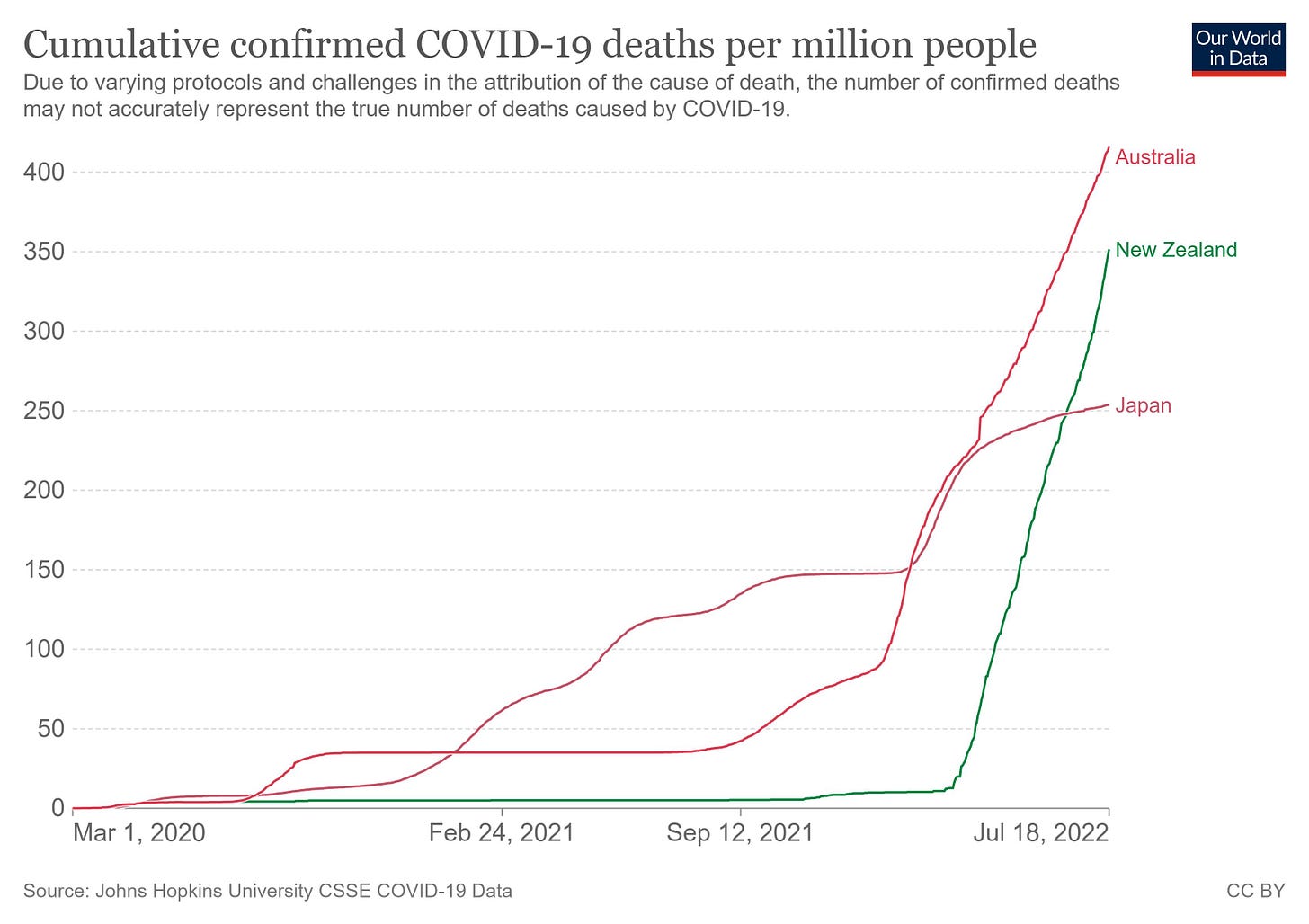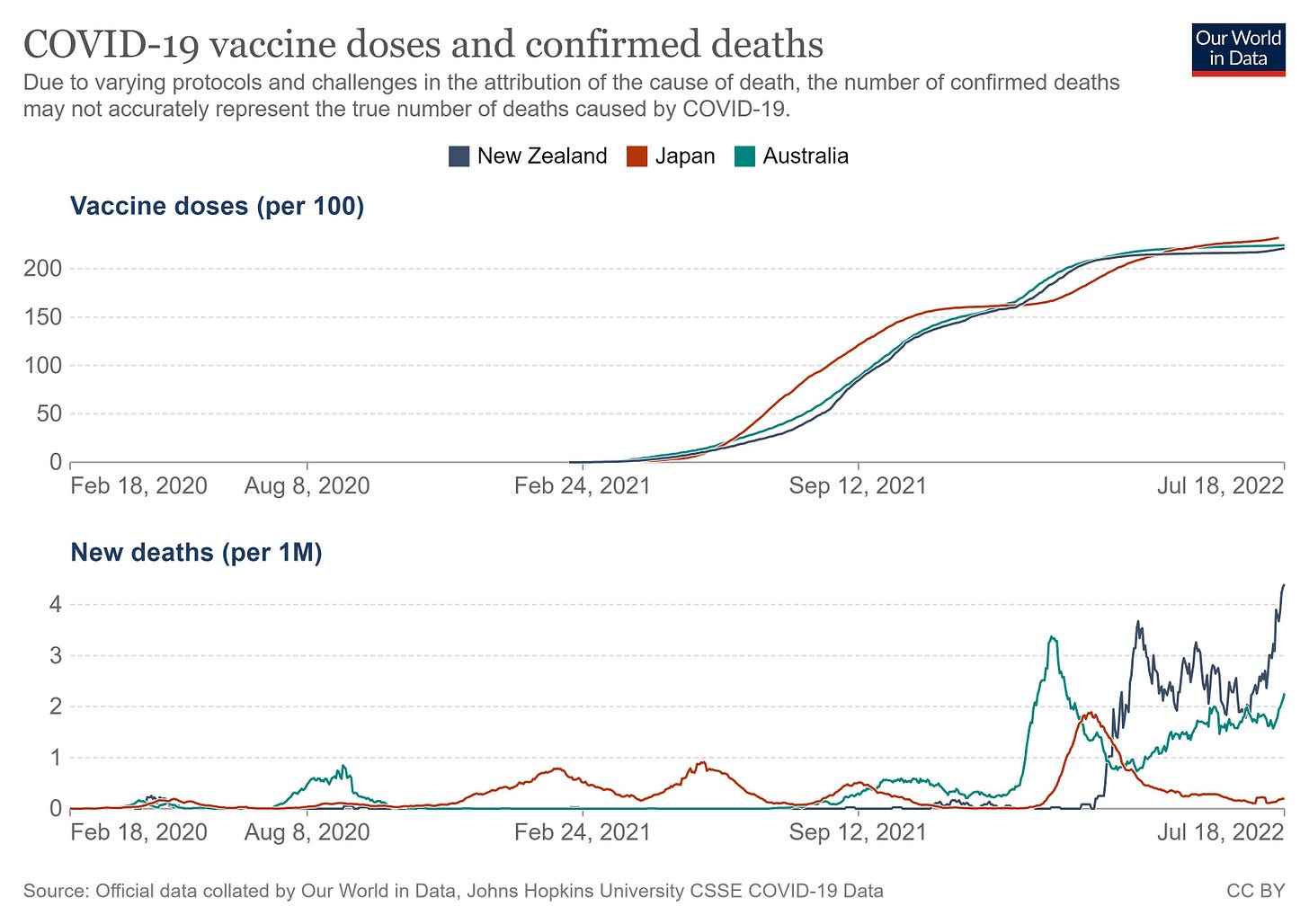When the COVID gods mock Zero COVID – a Graphical Essay
Sympathizing with Jacinda Ardern, New Zealand’s Empathizer-in-Chief
Clockwise from the top-left: Victoria Premier Dan Andrews, just-retired Chief Minister of the Northern Territories Michael Gunner, New Zealand Prime Minister Jacinda Ardern, First Minister of Scotland Nicola Sturgeon, Canadian Prime Minister Justin Trudeau.
Our friends at UnHerd came out yesterday (July 19) with a short, crisp piece titled “New Zealand falls out of love with Jacinda Ardern: The once popular Kiwi leader is crashing in the polls.”
The crash in the polls is credited to “a cost of living crisis brought about by the highest inflation in three decades, stagnating wages and economic growth, unaffordable housing, a health system running on fumes, and a rise in violent crime.” The piece assigns less credit to “the Zero Covid approach,” because “New Zealand is moving on from the pandemic.” The evidence for this last point seems to be the assertion that “once Ardern began shifting [from Zero Covid] to living with Covid at the end of 2021, the shine began to wear off.” COVID had already imposed its toll on the polling. It’s old news. The electorate has already absorbed it and evaluated it.
Perhaps that is a reasonable way to think of things, but one can’t help but sympathize with the leadership in New Zealand when it comes to inflation and rising costs. The world can probably assign a lot of blame for that to the Biden administration and its policies of digitally printing $trillions. That is a subject for another essay, but as far as COVID goes, one might wonder if New Zealand’s ongoing experience with COVID just these last few months might yet inform what is going on in the polls. Consider the following graph projected from data generously provided to us by our friends at Our World in Data:
Fatalities attributed to COVID in New Zealand numbered in the very small digits until the beginning of March of this year. New Zealand is now experiencing COVID mortality that looks much like the volume of mortality experienced in other countries. Indeed, compare New Zealand’s experience to that of … the United States.
It is only now that New Zealand is experiencing anything on the scale that the United States (or Europe or almost anywhere in the developed world) has experienced. These days, COVID mortality in the United States clocks in at less than half the rate of COVID mortality in New Zealand. What is going on?
Long story short: Anyone who claims to know definitively what is going on—whether the health authorities in New Zealand, the authorities in Australia, the insufferable Tony Fauci, anyone—would be putting us on. Much of the population may yet believe in the conceit that the authorities can channel and corral COVID, but there is no evidence they can point to in order to establish their point. Rather, there is abundant evidence that blows up that conceit. Worse for them, their point leaves them politically vulnerable when the COVID gods do choose to mock their efforts. At the very least, the data show that Zero COVID has proven unachievable even by the island hermit kingdom of New Zealand. But, wait. What of, say, the Central African republic of Burundi? Consider the following graph:
If you blink your eyes, you might miss the difference. Look closely. If any country achieved near-Zero COVID, it was Burundi, one of the poorest countries in the world. Burundi’s magic is strong. What is it?
Burundi’s magic is the fact that the country’s age distribution skews very young. The median age in Burundi is about 17.5 years. Hard to beat that magic when your median age is 37.9 (New Zealand) or 38.3 (United States). I explored this point in May in an essay titled “Death-by-Expert – a Cross-country Study.”
One might be tempted to sympathize with the leadership in New Zealand. The diffusion of viruses has proven to be a tricky thing—a thing that is trickier and harder to understand than public health authorities have been willing to admit. But they come off as unsympathetic characters in that they exploited the conceit that they really could achieve Zero COVID with competent leadership. They thus prove to be either incompetent (incapable of controlling the diffusion of viruses) or opportunistic (willing to exploit the fiction that they could control the diffusion of viruses). That is not good for a regime that marketed itself as “authentic”. “Open, honest and effective: What makes Jacinda Ardern an authentic leader,” read a piece in The Conversation, an online publication that, in the estimation of its own editors, opens the world to us with “academic rigor” and “journalistic flair.”
Her coolness under pressure, self-discipline and the decisiveness of her government’s response to the COVID-19 pandemic has led some to call Ardern the most effective national leader in the world.
But the key ingredient to her popularity and effectiveness is her authenticity.
Ah, well… Be that as it may, let’s consider New Zealand’s recent COVID experience with its peer Australia as well as with Japan.
All three countries have experienced something of a spurt in COVID mortality in 2022, with Japan leading the way. But, COVID seems to have cooled off in Japan. For now. Meanwhile, the trajectories of COVID fatalities in Australia and New Zealand have yet to show signs of dissipating. But, they will dissipate, and they will dissipate absent any government interventions. That is Farr’s Law. As I wrote in January in a piece titled “The Orpheus Fallacy”:
[H]ospitalizations, cases and fatalities eventually decline. But these things were going to decline with or without interventions. That’s called Farr’s Law.
In a “Letter to the Registrar-General from William Farr, Esq.,” dated June, 1840, William Farr observed that “Five [people] die weekly of smallpox in the metropolis [London] when the disease is not epidemic; …” So, smallpox was always out there in the miasma. But why would smallpox (1) sometimes breakout in epidemics and then (2) recede on its own back its baseline rate of about five fatalities a week? “Why do the five deaths become 10, 15, 20, 31, 58, 88 weekly, and then progressively fall through the same measured steps?”
Farr’s Law is not so much of a law as … a regularity… Farr’s regularity is that epidemics have this way of winding down that looks much like the mirror image of the way they had wound up; something clicks and seemingly exponential increase gives way to something that looks a lot like exponential decay.
At some point the increasing rates of COVID mortality in Australia and New Zealand will give way to exponential decline. We just don’t know when. Any prediction is garbage. Golden, however, will be the prediction that the authorities will claim unmerited credit for the decline when the mischievous COVID gods deign to bless us with a decline.
Accounting for COVID fatalities has its place, but let’s consider other measures of country-wide performance. Given the fact that COVID concentrates its toll on immunologically vulnerable people, it mostly takes away people who are not long for this world. COVID may take away people who were likely to be taken away by something else. It is not immediately obvious, therefore, that the coronavirus phenomenon would much affect total, all-cause mortality over time. Once COVID has burned through the population, “excess,” all-cause mortality might exhibit some flux but should revert to zero. So, what has happened to date in New Zealand, Australia, and Japan? Consider the following graph:
It is hard not to suggest that stringent lockdown policies in Australia and New Zealand really did contain all-cause mortality in the early half of the COVID experience. In contrast, in the United States and in much of Europe, COVID induced some measure of excess mortality. But lockdowns and other policies also induced much non-COVID excess mortality, especially in people of prime working age. The how and why of it remains a puzzle—a puzzle that the authorities are in no rush to solve. If anything, they are too busy trying to dismiss unusually high mortality among younger, working age people as manifestations of a mythical SADS, “Sudden Adult Death Syndrome.” (Even the Australian authorities aggressively push the SADS narrative.) Blame anything, but not the adverse effects of the vaccines or (in the United States) the influx of Chinese-made fentanyl and other drugs over the unpoliced border with Mexico. Blame anything, including the phantom of SADS, other than public policy.
The coronavirus phenomenon is complex for many reasons, one being that the trajectories of excess mortality can be hard to understand. Less complex, perhaps, is the performance of the ersatz vaccines, the mRNA therapies. Consider the following graph:
This graph pairs vaccine doses per 100 people in the population to weekly fatalities attributed to COVID. All three countries have secured more than two doses per person several months ago (more than 200 doses per 100 people). COVID mortality in Japan and Australia did experience something of a spike, but it has reverted to near zero in Japan. We will see if that keeps up. Meanwhile, COVID mortality in Australia and New Zealand has been elevated. What to make of this?
Various parties have identified counter-intuitive mechanisms by which vaccinations could make populations more susceptible, rather than less susceptible, to broad diffusion of the virus. Whether or not such mechanisms are at work is not something that is easy to establish—not with publicly-available data, anyway. But, we can state the abundantly obvious: The vaccines don’t work. They don’t impart immunity. They don’t keep people from spreading it to others. These data even exhibit high correlation between COVID fatalities and vaccination rates. So, again, the vaccines don’t work. They might even be affirmatively harmful. This is not news. And, yet, one can imagine that the vaccines do induce second-order effects. Or not. Either way, the health authorities have certainly encouraged us to perceive second-order effects. Specifically, once it became too obvious for the authorities to ignore the failures of the vaccines, the authorities asserted that the vaccines would mitigate COVID-induced harm in the event of infection. I have heard people report this to me myself: “I’m so glad I’ve been vaccinated. It will help reduce the effects of infection, blah, blah, blah …” It is not obvious that any of that is true, but evaluating such a proposition could require access to individual-level data. The authorities will not provide those data, surely, and we can’t count on them to report the results of such studies on their own.
The Anglosphere has been on fire. Public policy on almost any dimension—coronavirus mitigation, education, immigration, fiscal policy, monetary policy, energy policies … it’s all been subordinated to some weird authoritarian program. At least in the United States there are rumblings of electoral consequences in 2022. Some prospect for changing, challenging or frustrating corrupt and destructive leadership remains a real thing. Less so, it seems, in the British Commonwealth and Ireland.
England, Ireland, Scotland, Wales, Canada, Australia, New Zealand… I can’t pretend to be well informed about the status of real political competition in these countries, but from my perch governance seems less subject to competition than in the United States. It must be the case that proportions of the electorates in all of these countries that buy into the authorities’ rhetoric are large enough to allow the authorities to get away with imposing policies that are either demonstrably ineffective or likely harmful. But, perhaps the “crash in the polls” in New Zealand suggests that there may yet be some near-term prospect for change. Participate in your local “freedom haka.”
More than a year ago the world started to wonder, “What is going on in Australia?” The leadership in the Australian states of Victoria (premier Dan Andrews) and the Northern Territories (chief minister, just retired, Michael Gunner) represent the worst of it. They are what New Zealand prime minister Jacinda Ardern pretends to be: actually authentic, albeit without any suggestion of “empathy”. Ardern may put on a show of authenticity and empathy that much of the electorate finds convincing, but the leadership in Australia can at least take credit for showing the world what they really are. Here’s an example of Michael Gunner doing just that, courtesy of The Guardian: ‘Stuff it, shove it’: a furious Michael Gunner callsout those against vaccine mandates – video
Bonus material: This is what evil looks like, bug-eyed fury and all.
Michael Gunner Flip Book


















Really great article that touches a lot of sore points. The UK colonies certainly have suffered a lot of freedom losses in this pandemic that people are starting to awaken to awful leadership. It seems to take time for the masses to see what's happening. In the US the contrasts between red/blue states clearly showed policy matters. Whether that is pointing to a real change remains to be seen. Clearly the promises of the novel mRNA platform haven't arrived and a deep dive into why has yet to happen.
The EU has suggested that member states should consider mandatory vaccination. I think some states such as Austria and France had policies which were close to mandatory vaccination. Thank goodness the UK did not go down that path. I would be appalled if that happened here (UK).
Thanks for your excellent article.